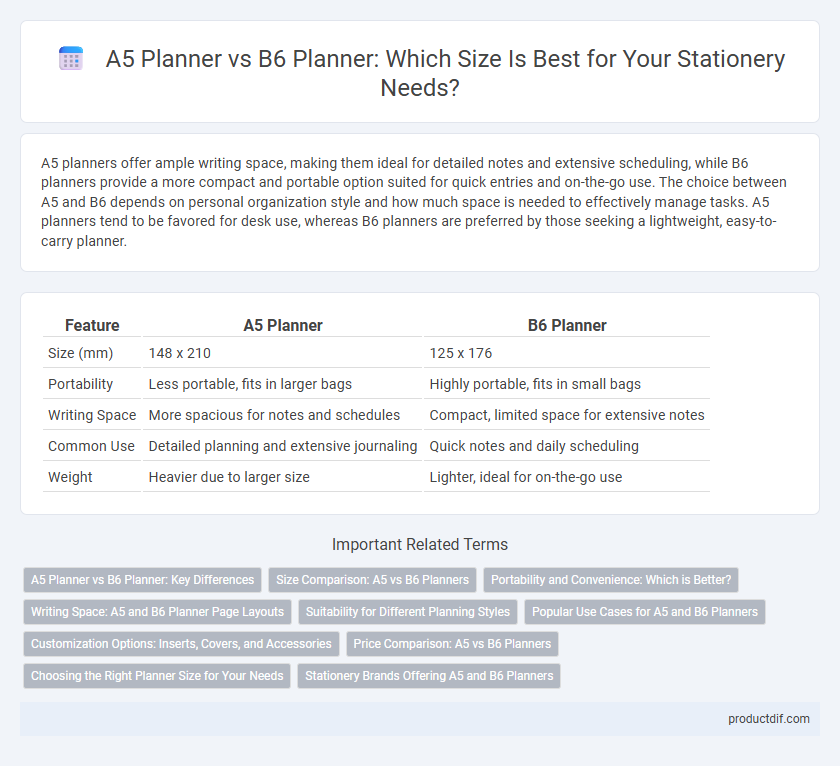A5 planners offer ample writing space, making them ideal for detailed notes and extensive scheduling, while B6 planners provide a more compact and portable option suited for quick entries and on-the-go use. The choice between A5 and B6 depends on personal organization style and how much space is needed to effectively manage tasks. A5 planners tend to be favored for desk use, whereas B6 planners are preferred by those seeking a lightweight, easy-to-carry planner.
Table of Comparison
| Feature | A5 Planner | B6 Planner |
|---|---|---|
| Size (mm) | 148 x 210 | 125 x 176 |
| Portability | Less portable, fits in larger bags | Highly portable, fits in small bags |
| Writing Space | More spacious for notes and schedules | Compact, limited space for extensive notes |
| Common Use | Detailed planning and extensive journaling | Quick notes and daily scheduling |
| Weight | Heavier due to larger size | Lighter, ideal for on-the-go use |
A5 Planner vs B6 Planner: Key Differences
A5 planners are larger, measuring 148 x 210 mm, offering more writing space and ideal for detailed scheduling, while B6 planners at 125 x 176 mm provide a more compact, portable option. The A5 format supports more extensive notes and is suited for professional or academic use, whereas B6 planners are favored for everyday carry and minimalistic planning. Paper layout and weight options vary, impacting usability depending on whether users prioritize space or convenience.
Size Comparison: A5 vs B6 Planners
A5 planners measure approximately 148 x 210 mm, offering a spacious layout ideal for detailed notes and extensive daily planning, while B6 planners, at around 125 x 176 mm, provide a more compact and portable option suited for minimalist scheduling. The larger A5 size enhances readability and writing comfort, making it popular among users who prioritize space over portability. In contrast, B6 planners balance functionality with convenience, fitting easily into smaller bags and encouraging quick, on-the-go organization.
Portability and Convenience: Which is Better?
A5 planners offer more writing space, making them ideal for detailed scheduling but can be less portable due to their larger size. B6 planners are compact and lightweight, enhancing portability and convenience for on-the-go use while sacrificing some writing area. Choosing between A5 and B6 depends on balancing the need for ample space versus ease of carrying in daily activities.
Writing Space: A5 and B6 Planner Page Layouts
A5 planners offer larger writing space with dimensions around 5.8 x 8.3 inches, providing ample room for detailed notes and daily schedules, while B6 planners, measuring approximately 4.9 x 6.9 inches, feature a more compact layout suited for concise entries and portability. The A5 page layout typically includes wider margins and more spacious grids or lines, enhancing clarity and organization for extensive planning tasks. In contrast, the B6 planner's page design caters to minimalistic writing styles, optimizing space efficiency without overwhelming users.
Suitability for Different Planning Styles
A5 planners offer ample space for detailed daily schedules and extensive notes, making them ideal for users who prefer comprehensive planning and elaborate to-do lists. B6 planners, being more compact, suit individuals who favor minimalist layouts or bullet journaling with concise entries and quick reference. The choice between A5 and B6 formats hinges on whether the planner user values spacious organization or portability combined with efficient planning.
Popular Use Cases for A5 and B6 Planners
A5 planners are popular for detailed daily scheduling and note-taking, commonly used by students, professionals, and bullet journal enthusiasts due to their spacious layout. B6 planners are favored for portability and quick, on-the-go planning, making them ideal for busy commuters and minimalists who prefer compact organization tools. Both sizes cater to different needs, with A5 offering ample writing space and B6 providing convenience and ease of carry.
Customization Options: Inserts, Covers, and Accessories
A5 planners offer extensive customization options with a wide variety of inserts, including daily, weekly, and monthly layouts, along with refillable covers that support different materials like leather or fabric, and compatible accessories such as pen loops and cardholders. B6 planners provide a more compact format, featuring tailored inserts ideal for minimalist planning, interchangeable covers for lightweight portability, and accessories designed to maintain a slim profile while enhancing functionality. Choosing between A5 and B6 planners depends on the desired balance between ample space for personalization and convenient, portable customization options.
Price Comparison: A5 vs B6 Planners
A5 planners typically offer a larger writing surface, often coming at a slightly higher price due to increased paper usage and more substantial binding materials. B6 planners tend to be more compact and portable, making them generally less expensive while still providing adequate space for daily scheduling. Price differences between A5 and B6 planners largely depend on brand, paper quality, and features such as customization or additional inserts.
Choosing the Right Planner Size for Your Needs
Choosing the right planner size depends on your daily organization needs and portability preferences. An A5 planner offers ample writing space, ideal for detailed notes and extensive planning, while a B6 planner provides a compact, lightweight option perfect for on-the-go use. Consider factors like the amount of content you typically record and how often you carry your planner to decide whether the A5 or B6 size better suits your lifestyle.
Stationery Brands Offering A5 and B6 Planners
Stationery brands such as Hobonichi, Midori, and Leuchtturm1917 provide both A5 and B6 planners, catering to diverse preferences in size and usability. A5 planners offer ample writing space ideal for detailed planning, while B6 planners are more compact, suited for portability without sacrificing functionality. These brands emphasize quality paper and customizable layouts, enhancing the planning experience for professionals and students alike.
A5 planner vs B6 planner Infographic

 productdif.com
productdif.com